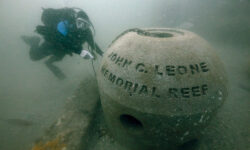7-6-12
While offshore St. Augustine collecting reef site imagery for Reefs Revealed mapping efforts, TISIRI divers decided to investigate a random area of sea floor that appeared to be holding fish (according to the depth finder display). When divers hit the sea floor they were welcomed by sand and a school of bait fish but no structure. TISIRI investigators decided to swim an expanding circular pattern and when doing so a weed like structure was encountered. This "weed" turned out to be a piece of stainless steal and not far from it the aircraft engine block shown below was discovered.
It appears the divers have discovered the wreckage of a plane crash. Unfortunately the only obvious structure located was the engine and some metal structures. It is not apparent if more of the wreck material is buried or has decayed. Please take a look at the pictures and let us know in the comments below about how we might go about learning more about this wreck. Thanks
















Lycoming engine, I would guess a civilian aircraft. Interersting find, please keep us posted as you learn more about the aircraft.
WOW!! Quite an interesting find.
Holy cow! That is like finding a needle in a haystack. Really cool, I am dying to know what you find out about the aircraft.
Best result would be to search the Serial Number on the Lycoming Engine and then simply call Lycoming. Their Phone Number is
717-327-7019
With the Serial Number which is found as a stamping on the motor flange bolt at the case they can tell you the date and location of engine build as well as what aircraft the motor was originally put in. They may even have maintenance records or a rebuild date since some owners have their Lycomings rebuilt by Lycoming at the requisite overhaul hours.
That will at least narrow your time frame for the search.
Good luck.
Dan,
Any chance you could better describe where that stamping might be? Thanks
Could the two vintage air craft crashes you found have come from the historical missing Flight 19 out of Ft Lauderdale?
Hi,
Based on the pictures it looks like you found a
http://en.wikipedia.org/wiki/Lycoming_O-540
These are used in the piper aerostar as well as other aircraft.
It looks like there are different rocker covers on the visible cylinders. Those are the parts that say “Lycoming” on them. Notice one says “Lycoming” and the other two say “Avco Lycoming” That means that one of them has probably been rebuilt or replaced at some point. If you are able to check maintenance records on the suspect aircraft, this will have been documented. There also should be a data plate on top of the case on the top of the cylinders. This may have been knocked off or corroded away at this point. The propeller hubs will also have serial numbers stamped on them as well as the flywheel, which is the large toothed part at the end of the engine.
My Lycoming 0-540 has it’s dataplate towards the bottom of the engine on the right side of the engine.
You would have to dig underneath the right bank of cylinders to find the dataplate (i.e. with the prop to your right, dig below the left two cylinders). Picture “8/12” shows exactly where to dig. It’s an aluminum plate rivited to the crankcase.
It’s quite possible that the engine broke loose on impact with the water, and the rest of the plane is elsewhere. The engine would have gone straight down while the fuselage had potential to not only drift while sinking, but would also be light enough without the engine that currents could have taken it quite a ways away. Arcraft structural tubing is very high quality steel and probably would corrode slower than the engine, so I doubt that it has corroded.
Finding the data plate on the engine would be your best bet. It’s a slim chance that the serial number could lead you to more information, but unelss you find the rest of the plane, it’s your only chance.
Bowen Udall is mostly correct. However, most data plates I’ve seen are actually stainless steel and will pry off relatively easily. They are normally located on the RH side of the oil sump under the #3 cylinder (2nd from the ring gear). The serial number is useful, but the engine model number will help to quickly identify which aircraft type it was mounted on. For starters, this looks like an O-540. This means that it was naturally aspirated, had a carburetor, and was a direct drive engine. Although Lycoming O-540’s are very popular, judging by the fact that it is non-fuel injected it is probably off of an older Piper aircraft of some sort. Most Cessna’s used Continental engines until recently. I will show these images to several co-workers and see If I can get a better ID on the engine model. Good luck!
Correction: *Most Cessna’s utilizing a 6 cylinder engine used Continentals*
Thanks for the continued insights. Just a reminder we have more recent pictures of this wreckage here http://www.tisiri.org/tisiri-raises-aircraft-engine-investigation/
We have been unable to locate an engine data plate as the oil sumps are missing. However we did find a prop # and this has led our investigation to believe this aircraft was a Piper Aztec.
Pretty good post. I just stumbled upon your blog and wanted to say that I have extremely enjoyed reading your blog posts. Any way I will be subscribing for ones feed and I hope you article again soon.